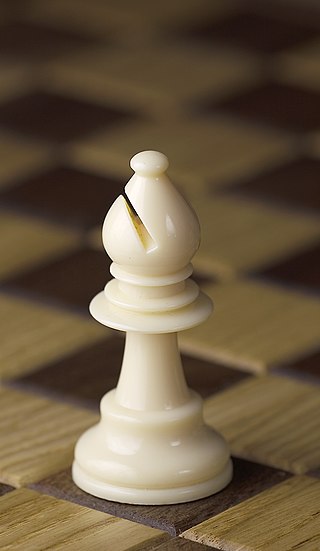
The bishop is a piece in the game of chess. It moves and captures along diagonals without jumping over intervening pieces. Each player begins the game with two bishops. The starting squares are c1 and f1 for White's bishops, and c8 and f8 for Black's bishops.

The knight is a piece in the game of chess, represented by a horse's head and neck. It moves two squares vertically and one square horizontally, or two squares horizontally and one square vertically, jumping over other pieces. Each player starts the game with two knights on the b- and g-files, each located between a rook and a bishop.
In the game of chess, perpetual check is a situation in which one player can force a draw by an unending series of checks. This typically arises when the player who is checking cannot deliver checkmate, and failing to continue the series of checks gives the opponent at least a chance to win. A draw by perpetual check is no longer one of the rules of chess; however, such a situation will eventually allow a draw claim by either threefold repetition or the fifty-move rule. Players usually agree to a draw long before that, however.
Zugzwang is a situation found in chess and other turn-based games wherein one player is put at a disadvantage because of their obligation to make a move; a player is said to be "in zugzwang" when any legal move will worsen their position.
Stalemate is a situation in chess where the player whose turn it is to move is not in check and has no legal move. Stalemate results in a draw. During the endgame, stalemate is a resource that can enable the player with the inferior position to draw the game rather than lose. In more complex positions, stalemate is much rarer, usually taking the form of a swindle that succeeds only if the superior side is inattentive. Stalemate is also a common theme in endgame studies and other chess problems.

Checkmate is any game position in chess and other chess-like games in which a player's king is in check and there is no possible escape. Checkmating the opponent wins the game.
The two knights endgame is a chess endgame with a king and two knights versus a king. In contrast to a king and two bishops, or a bishop and a knight, a king and two knights cannot force checkmate against a lone king. Although there are checkmate positions, a king and two knights cannot force them against proper, relatively easy defense.
Triangulation is a tactic used in chess to put one's opponent in zugzwang. Triangulation is also called losing a tempo or losing a move.
The chess endgame with a king and a pawn versus a king is one of the most important and fundamental endgames, other than the basic checkmates. It is an important endgame for chess players to master, since most other endgames have the potential of reducing to this type of endgame via exchanges of pieces. Players need to be able to determine quickly whether a given position is a win or a draw, and to know the technique for playing it. The crux of this endgame is whether or not the pawn can be promoted, so checkmate can be forced.

El Ajedrecista is an automaton built in 1912 by Leonardo Torres Quevedo in Madrid, one of the first autonomous machines capable of playing chess. As opposed to the human-operated The Turk and Ajeeb, El Ajedrecista had a true integrated automation built to play chess without human guidance. It played an endgame with three chess pieces, automatically moving a white king and a rook to checkmate the black king moved by a human opponent.
In chess, a fortress is an endgame drawing technique in which the side behind in material sets up a zone of protection that the opponent cannot penetrate. This might involve keeping the enemy king out of one's position, or a zone the enemy cannot force one out of. An elementary fortress is a theoretically drawn position with reduced material in which a passive defense will maintain the draw.
The bishop and knight checkmate in chess is the checkmate of a lone king which can be forced by a king, a bishop, and a knight. With the stronger side to move and with perfect play, checkmate can be forced in at most thirty-three moves from any starting position where the defender cannot quickly win one of the pieces. The exception is the "stalemate trap". These exceptions constitute about 0.5% of the positions. Checkmates are possible with the defending king on any square at the edge of the board but can be forced only from positions with different material or if the defending king is in a corner controlled by the bishop or on a square on the edge next to a corner; however, mate adjacent to the corners not controlled by the bishop is only two moves deep, so it is not generally encountered unless the defending side plays inaccurately. Although this is classified as one of the four basic or elementary checkmates, it occurs in practice only approximately once in every 6,000 games.
The rook and pawn versus rook endgame is a fundamentally important, widely studied chess endgame. Precise play is usually required in these positions. With optimal play, some complicated wins require sixty moves to either checkmate, capture the defending rook, or successfully promote the pawn. In some cases, thirty-five moves are required to advance the pawn once.
The chess endgame of a queen versus pawn is usually an easy win for the side with the queen. However, if the pawn has advanced to its seventh rank it has possibilities of reaching a draw, and there are some drawn positions with the pawn on the sixth rank. This endgame arises most often from a race of pawns to promote.
The opposite-colored bishops endgame is a chess endgame in which each side has a single bishop and the bishops reside on opposite-colored squares. Without other pieces besides pawns, these endings are widely known for their tendency to result in a draw. These are the most difficult endings in which to convert a small material advantage to a win. With additional pieces, the stronger side has more chances to win, but not as many as when bishops are on the same color.
A pawnless chess endgame is a chess endgame in which only a few pieces remain, and no pawns. The basic checkmates are types of pawnless endgames. Endgames without pawns do not occur very often in practice except for the basic checkmates of king and queen versus king, king and rook versus king, and queen versus rook. Other cases that occur occasionally are (1) a rook and minor piece versus a rook and (2) a rook versus a minor piece, especially if the minor piece is a bishop.
The queen and pawn versus queen endgame is a chess endgame in which both sides have a queen and one side has a pawn, which one tries to promote. It is very complicated and difficult to play. Cross-checks are often used as a device to win the game by forcing the exchange of queens. It is almost always a draw if the defending king is in front of the pawn.
The camel or long knight is a fairy chess piece with an elongated knight move. It can jump three squares horizontally and one square vertically or three squares vertically and one square horizontally, regardless of intervening pieces. Therefore, it is a (1,3)-leaper.

The zebra is a fairy chess piece that moves like a stretched knight. It jumps three squares horizontally and two squares vertically or three squares vertically and two squares horizontally, regardless of intervening pieces; thus, it is a (2,3)-leaper. A lame zebra, which moves one step orthogonally and then two steps diagonally outwards and can be blocked by intervening pieces, appears as the elephant in janggi.
Chess on a really big board is a large chess variant invented by Ralph Betza around 1996. It is played on a 16×16 chessboard with 16 pieces and 16 pawns per player. Since such a board can be constructed by pushing together four standard 8×8 boards, Betza also gave this variant the alternative names of four-board chess or chess on four boards.






